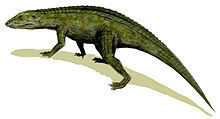
Archosauria is a clade of diapsids, with birds and crocodilians as the only living representatives. Archosaurs are broadly classified as reptiles, in the cladistic sense of the term, which includes birds. Extinct archosaurs include non-avian dinosaurs, pterosaurs, and extinct relatives of crocodilians. Modern paleontologists define Archosauria as a crown group that includes the most recent common ancestor of living birds and crocodilians, and all of its descendants. The base of Archosauria splits into two clades: Pseudosuchia, which includes crocodilians and their extinct relatives, and Avemetatarsalia, which includes birds and their extinct relatives.

Crurotarsi is a clade of archosauriform reptiles that includes crocodilians and stem-crocodilians and possibly bird-line archosaurs too if the extinct, crocodile-like phytosaurs are more distantly related to crocodiles than traditionally thought. Prior to 2011, the group had invariably included only archosaurs closer to crocodilians than to birds and other dinosaurs. An equivalent term for the crocodilian side of the archosaur family tree is Pseudosuchia. This traditional definition of Crurotarsi assumed that phytosaurs were crown-group archosaurs and more closely related to crocodilians than to birds. However, a 2011 study argued that the phytosaur lineage evolved prior to the split between birds and crocodilians. This would mean that phytosaurs were not true archosaurs, and therefore could not be considered representatives of croc-line archosaurs.

Pseudosuchia is one of two major divisions of Archosauria, including living crocodilians and all archosaurs more closely related to crocodilians than to birds. Pseudosuchians are also informally known as "crocodilian-line archosaurs". Despite Pseudosuchia meaning "false crocodiles", the name is a misnomer as true crocodilians are now defined as a subset of the group.

Mesoeucrocodylia is the clade that includes Eusuchia and crocodyliforms formerly placed in the paraphyletic group Mesosuchia. The group appeared during the Early Jurassic, and continues to the present day.

Avemetatarsalia is a clade of diapsid reptiles containing all archosaurs more closely related to birds than to crocodilians. The two most successful groups of avemetatarsalians were the dinosaurs and pterosaurs. Dinosaurs were the largest terrestrial animals for much of the Mesozoic Era, and one group of small feathered dinosaurs has survived up to the present day. Pterosaurs were the first flying vertebrates and persisted through the Mesozoic before dying out at the Cretaceous-Paleogene (K-Pg) extinction event. Both dinosaurs and pterosaurs appeared in the Triassic Period, shortly after avemetatarsalians as a whole. The name Avemetatarsalia was first established by British palaeontologist Michael Benton in 1999. An alternate name is Pan-Aves, or "all birds", in reference to its definition containing all animals, living or extinct, which are more closely related to birds than to crocodilians.

Crocodylomorpha is a group of pseudosuchian archosaurs that includes the crocodilians and their extinct relatives. They were the only members of Pseudosuchia to survive the end-Triassic extinction.
Elosuchus is an extinct genus of neosuchian crocodyliform that lived during the Middle Cretaceous of what is now Africa.

Pelagosaurus is an extinct genus of thalattosuchian crocodyliform that lived during the Toarcian stage of the Lower Jurassic, around 183 Ma to 176 Ma, in shallow epicontinental seas that covered much of what is now Western Europe. The systematic taxonomy of Pelagosaurus has been fiercely disputed over the years, and was assigned to Thalattosuchia after its systematics within Teleosauridae were disputed. Pelagosaurus measured 2–3 m (6.6–9.8 ft) long and weighed 60 kg (130 lb).

Notosuchia is a suborder of primarily Gondwanan mesoeucrocodylian crocodylomorphs that lived during the Jurassic and Cretaceous. Some phylogenies recover Sebecosuchia as a clade within Notosuchia, others as a sister group ; if Sebecosuchia is included within Notosuchia its existence is pushed into the Middle Miocene, about 11 million years ago. Fossils have been found from South America, Africa, Asia, and Europe. Notosuchia was a clade of terrestrial crocodilians that evolved a range of feeding behaviours, including herbivory (Chimaerasuchus), omnivory (Simosuchus), and terrestrial hypercarnivory (Baurusuchus). It included many members with highly derived traits unusual for crocodylomorphs, including mammal-like teeth, flexible bands of shield-like body armor similar to those of armadillos (Armadillosuchus), and possibly fleshy cheeks and pig-like snouts (Notosuchus). The suborder was first named in 1971 by Zulma Gasparini and has since undergone many phylogenetic revisions.

Baurusuchidae is a Gondwanan family of mesoeucrocodylians that lived during the Late Cretaceous. It is a group of terrestrial hypercarnivorous crocodilians from South America and possibly Pakistan. Baurusuchidae has been, in accordance with the PhyloCode, officially defined as the least inclusive clade containing Cynodontosuchus rothi, Pissarrachampsa sera, and Baurusuchus pachecoi. Baurusuchids have been placed in the suborder Baurusuchia, and two subfamilies have been proposed: Baurusuchinae and Pissarrachampsinae.

Eusuchia is a clade of neosuchian crocodylomorphs that first appeared in the Early Cretaceous, which includes modern crocodilians. Along with Dyrosauridae and Sebecosuchia, they were the only crocodyliformes who survived the K-T extinction.

Alligatoroidea is one of three superfamilies of crocodylians, the other two being Crocodyloidea and Gavialoidea. Alligatoroidea evolved in the Late Cretaceous period, and consists of the alligators and caimans, as well as extinct members more closely related to the alligators than the two other groups.
Trematochampsidae is an extinct family of mesoeucrocodylian crocodylomorphs. Fossils are present from Madagascar, Morocco, Niger, Argentina, and Brazil. Possible trematochampsids have been found from Spain and France, but classification past the family level is indeterminant. The trematochampsids first appeared during the Barremian stage of the Early Cretaceous and became extinct during the late Maastrichtian stage of the Late Cretaceous.
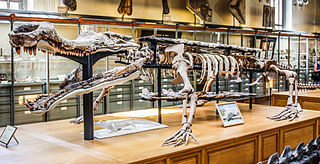
Neosuchia is a clade within Mesoeucrocodylia that includes all modern extant crocodilians and their closest fossil relatives. It is defined as the most inclusive clade containing all crocodylomorphs more closely related to Crocodylus niloticus than to Notosuchus terrestris. Members of Neosuchia generally share a crocodilian-like bodyform adapted to freshwater aquatic life, as opposed to the terrestrial habits of more basal crocodylomorph groups. The earliest neosuchian is suggested to be the Early Jurassic Calsoyasuchus, which lived during the Sinemurian and Pliensbachian stages in North America. It is often identified as a member of Goniopholididae, though this is disputed, and the taxon may lie outside Neosuchia, which places the earliest records of the group in the Middle Jurassic.
Stolokrosuchus is an extinct genus of neosuchian crocodylomorph that lived during the Early Cretaceous. Its fossils, including a skull with a long thin snout and bony knobs on the prefrontal, have been found in Niger. Stolokrosuchus was described in 2000 by Hans Larsson and Boubacar Gado. The type species is S. lapparenti. They initially described it as related to Peirosauridae, if not a member of that family. One study has shown it to be related to Elosuchus. However, more recent works usually find Stolokrosuchus to be one of the basalmost neosuchian, only distantly related to the elosuchid or pholidosaurid, Elosuchus. It was a semiaquatic crocodylomorph.
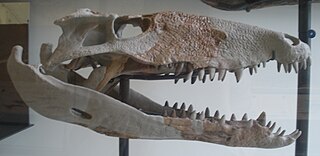
Metasuchia is a major clade within the superorder Crocodylomorpha. It is split into two main groups, Ziphosuchia and Neosuchia. Notosuchia is an extinct group that contains primarily small-bodied Cretaceous taxa with heterodont dentition. Neosuchia includes the extant crocodylians and basal taxa, such as peirosaurids and pholidosaurids. It is phylogenetically defined by Sereno et al. (2001) as a clade containing Notosuchus terrestris, Crocodylus niloticus, and all descendants of their common ancestor.
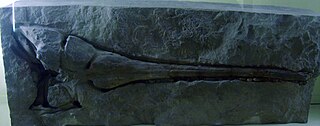
Pholidosaurus is an extinct genus of neosuchian crocodylomorph. It is the type genus of the family Pholidosauridae. Fossils have been found in northwestern Germany. The genus is known to have existed during the Berriasian-Albian stages of the Early Cretaceous. Fossil material found from the Annero and Jydegård Formations in Skåne, Sweden and on the island of Bornholm, Denmark, have been referred to as a mesoeucrocodylian, and possibly represent the genus Pholidosaurus.

Stratiotosuchus is an extinct genus of baurusuchid mesoeucrocodylian from the Adamantina Formation in Brazil. It lived during the Late Cretaceous. The first fossils were found in the 1980s, and the type species Stratiotosuchus maxhechti was named in 2001. A hyperpredator, it and other baurusuchids may have filled niches occupied elsewhere by theropod dinosaurs.
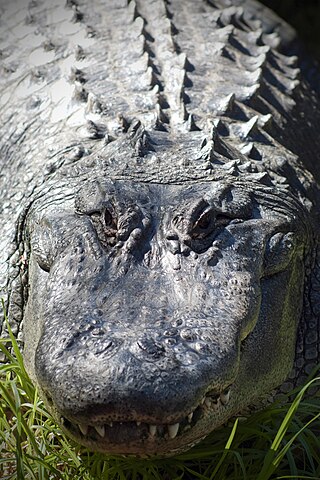
Brevirostres is a paraphyletic group of crocodilians that included alligatoroids and crocodyloids. Brevirostres are crocodilians with small snouts, and are distinguished from the long-snouted gharials. It is defined phylogenetically as the last common ancestor of Alligator mississippiensis and Crocodylus niloticus and all of its descendants. This classification was based on morphological studies primarily focused on analyzing skeletal traits of living and extinct fossil species, and placed the gharials outside the group due to their unique skull structure, and can be shown in the simplified cladogram below:

Planocraniidae is an extinct family of eusuchian crocodyliforms known from the Paleogene of Asia, Europe and North America. The family was coined by Li in 1976, and contains three genera, Boverisuchus, Duerosuchus and Planocrania. Planocraniids were highly specialized crocodyliforms that were adapted to living on land. They had extensive body armor, long legs, and blunt claws resembling hooves, and are sometimes informally called "hoofed crocodiles".
